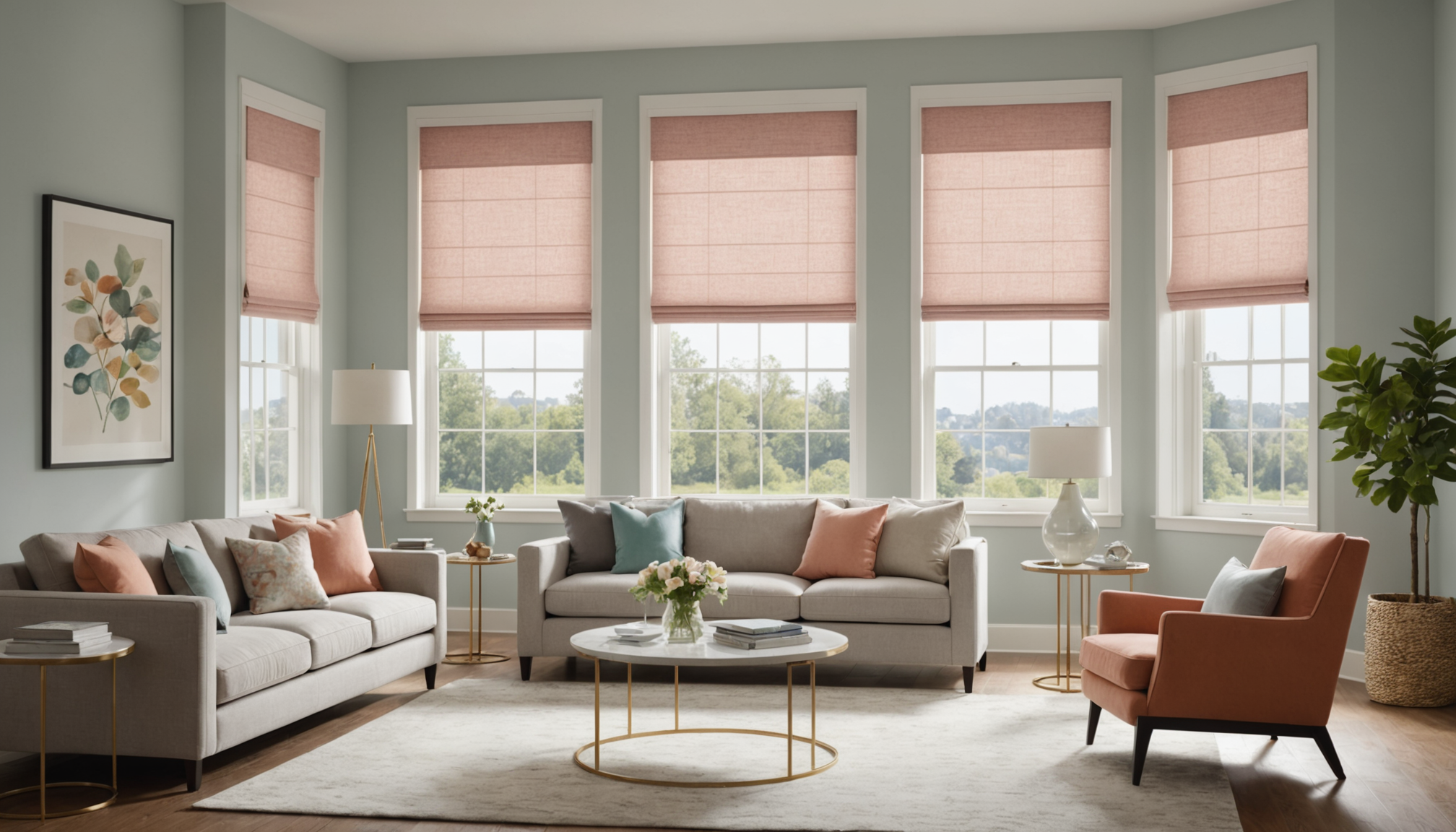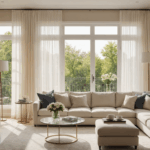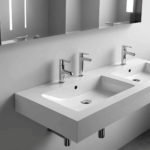When embarking on the journey to decorate your windows, selecting the right window treatments is paramount. Not only do they serve a crucial aesthetic function, but they also offer practical benefits that can enhance the energy efficiency and resale value of your home. The right choice can create harmony with your interior décor while providing necessary privacy and light control.
To make an informed decision, it’s essential to consider various factors such as the style of your windows, the overall design of your room, and the specific functionalities you desire. Window treatments come in many forms, each offering distinct advantages. Here, we will explore several popular options:
- Blinds: These offer a clean, modern look and allow you to control the amount of light entering a room. Blinds can be made from various materials including wood, faux wood, aluminum, and vinyl, each providing a different texture and feel. For those seeking energy savings, consider cellular or honeycomb blinds, which trap air and insulate the windows.
- Shades: Available in a plethora of styles, from Roman to roller or solar shades, they provide a soft and elegant window covering solution. Shades can help manage glare and protect furnishings from UV rays, while heavier, blackout varieties are ideal for bedrooms to block light completely.
- Shutters: Highly durable and offering a timeless appeal, shutters are an excellent choice for adding classic elegance and potential resale value to your property. Interior shutters complement various home styles, from colonial to contemporary, and provide excellent insulation and noise reduction.
- Draperies: With an extensive range of fabrics, colors, and patterns, draperies provide an opportunity to incorporate color and texture into your décor. They can be lined for additional energy efficiency and privacy, and when paired with sheer curtains, they create a versatile layering effect suitable for varying light conditions throughout the day.
Different treatments can also be combined to achieve layered effects that add depth and dimension to your space. This layering not only enhances the visual interest but can also improve functionality by combining aesthetic appeal with practical benefits like better thermal regulation and sound insulation.
Below is a comparison of some key attributes of these window treatment options to help guide your decision:
| Type | Light Control | Insulation | Maintenance |
| Blinds | Moderate to High | Low to Moderate | Easy |
| Shades | High | Moderate to High | Moderate |
| Shutters | Moderate | High | Low |
| Draperies | High | High | High |
By taking into account the specific needs and decorative style of your space, you can select window treatments that not only elevate the aesthetic appeal of your home but also contribute to energy savings and comfort. Whether you prioritize style, function, or both, the right choice will beautifully integrate with your overall interior design strategy.
Incorporating color and texture
When considering the infusion of color and texture into your window décor, it’s essential to strike a delicate balance between aesthetic appeal and functionality. Here are some practical steps and ideas to guide you through incorporating these vital design elements:
1. Understand the Room's Color Scheme:
– Begin by analyzing the existing color palette in your room. The window treatments should complement and enhance this scheme—not clash with or overpower it. For instance, if your room consists mainly of neutral tones, consider adding a splash of color with bold, vibrant draperies or shades.
2. Select the Right Fabric:
– Fabric choice significantly impacts both texture and the overall visual effect of your windows. Velvets and silks add a touch of luxury and opulence, while linens and cotton can offer a more relaxed and airy ambiance. Consider incorporating textured fabrics like brocade or jacquard for added depth.
3. Mix and Match Patterns:
– Introducing patterns is an excellent way to add interest and personality to your windows. Choose patterns that reflect the style and mood you wish to convey—floral designs foster a sense of nature and tranquility, while geometric patterns may impart a modern and edgy vibe.
– For a cohesive look, coordinate patterns with other elements in the room, such as upholstery or area rugs.
4. Incorporate Decorative Accents:
– Enhance your window treatments with decorative accents such as trims, tassels, or beaded fringe. These details not only elevate the aesthetic appeal but can also tie in with other decorative elements in the room.
5. Consider Layering Techniques:
– Use layering of textures and colors to create dimension and a dynamic look. A popular option is to combine sheer curtains with heavier drapes. This combination allows flexibility in controlling light while adding an element of luxurious depth.
6. Opt for Contrast or Harmony:
– Decide whether you want your window treatments to be a contrasting element or a harmonious addition. For a bold statement, choose colors and textures that stand out against the walls and furniture; for a subdued approach, opt for tones and materials that blend seamlessly with the existing décor.
7. Take Advantage of Natural Light:
– When selecting colors, consider how different shades will look in natural light. A fabric might appear differently when sunlight streams through it, altering its impact on the space. Test swatches at various times of the day to see how colors and textures react to changing light conditions.
8. Incorporate Eco-friendly and Energy-saving Materials:
– Consider using sustainable materials that offer energy-saving benefits. For instance, thermal or insulated draperies not only add texture but also help in reducing energy costs by maintaining indoor temperatures.
By thoughtfully incorporating color and texture into your window designs, you can profoundly impact the overall ambiance of your home. Whether through bold statements or subtle enhancements, these elements allow for creative expression while adding to the value and comfort of your living space.
Maximizing natural light
Maximizing the amount of natural light in your home not only enhances the aesthetic appeal of your interiors but also offers several practical benefits. This approach can transform a dimly lit room into a welcoming and vibrant space, while in more pragmatic terms, it is a fantastic way to achieve energy savings by reducing the need for artificial lighting and heating during daylight hours.
One of the most effective ways to harness natural light is by selecting the appropriate window treatments. When considering how to decorate for maximum light, opt for sheer or light-filtering fabrics, such as gauzy curtains or translucent shades. These allow sunlight to gently permeate the room while offering a degree of privacy.
For those seeking more flexibility, consider layering sheer curtains with heavier draperies. This combination offers the best of both worlds, allowing you to control the light entering the room effectively. During the day, you can draw the sheer panels to diffuse the sunlight, creating a soft and airy ambiance, while more opaque fabrics can be closed at night for privacy and insulation.
Placement and styling of furnishings also play a critical role in maximizing light. Position mirrors across from windows to reflect light throughout the room, which can make the space feel larger and more inviting. Consider rearranging furniture so that it does not block the light flow from windows. Low-profile or glass furniture pieces can further facilitate the distribution of light, enhancing the overall brightness.
Moreover, enhancing architectural features such as window sills and frames with a fresh coat of white or light-colored paint can help reflect additional light into the room. Selecting shades of paint that possess light-enhancing properties for your walls and ceilings also contributes significantly to the overall luminosity of a space.
Incorporating skylights or larger windows is an ambitious yet highly effective approach. While this requires a more significant investment, it can substantially increase natural light and boost the resale value of your home. Such changes not only enhance the comfort and attractiveness of your living space but also promote a sustainable environment by harnessing natural energy resources.
When planning landscaping around your home, consider the impact of foliage on natural light. While trees and bushes provide privacy and greenery, they should be strategically planted to avoid blocking too much light from entering your windows. Trim overgrown branches to allow more sunlight into your home, balancing the benefits of exterior greenery with the desire for a bright and airy interior.
Thoughtful planning and intentional choices in window decoration and room organization contribute to an environment that is both pleasurable and functional, capitalizing on the beauty and efficiency of natural light.
Adding decorative hardware
Elevating your window decor with decorative hardware is an essential step that can add character and style to your room’s overall appearance. Decorative hardware not only serves a practical purpose by supporting your window treatments but also enhances the aesthetic appeal, transforming ordinary windows into striking design features.
When choosing hardware, consider both function and form. The materials, finishes, and styles you select should complement your existing decor while providing necessary durability and support. Opt for robust materials such as wrought iron, brass, or stainless steel for prolonged use, particularly in high-traffic areas where window treatments are frequently opened and closed. If you’re aiming for a lighter and more delicate look, consider aluminum or metals with a satin finish.
Finials are a fantastic opportunity to infuse your personal style into your window design. From classic ball shapes and floral motifs to contemporary geometric designs, there is a wide variety to choose from. Coordinate your finial selection with other elements in the room, such as light fixtures or furniture, to create a cohesive design narrative. For a bold statement, opt for finials with intricate details or vibrant colors that stand out against the backdrop of your draperies.
Curtain rods and brackets play a vital role in the overall look and functionality of your window treatments. Select rods that match the overall style of your space—sleek and modern designs for contemporary settings or ornate and traditional choices for classic interiors. When installing, ensure the curtain rods extend several inches beyond the window frame; this allows your curtains to be drawn back completely without obstructing natural light or views, maximizing the perception of window size.
Tiebacks and holdbacks offer another layer of sophistication and practicality. They hold curtains in place, framing the window beautifully and allowing ample light to filter in. Choose tiebacks in complementary colors and materials for subtle elegance, or select decorative holdbacks featuring crystals or glass for a touch of glamour.
To further personalize your space, consider bespoke hardware options. Custom designs can address unique window shapes or non-standard lengths and can be an opportunity to incorporate thematic or personal elements in your decor. Engraving initials or selecting specific colors that tie into the overall room design can add a unique touch and increase the appeal.
Finally, for those focusing on energy savings and sustainable practices, choose hardware made from eco-friendly materials whenever possible. Look for suppliers who prioritize sustainable production methods or offer products made from recycled materials. Not only does this contribute to energy savings by reducing environmental impact, but it also enhances your home’s resale value with an eco-conscious approach.
By thoughtfully selecting and incorporating decorative hardware, you can greatly impact how your windows contribute to the overall design of your home. These final touches showcase your personal style while ensuring that your window treatments are not only functional but also impeccably fashionable. Remember, the right hardware can truly be the final touch that pulls together both the design and utility of your window decor.
Seasonal window décor ideas
As the seasons change, so too can the look and feel of your home’s interior. Transforming your windows with seasonal décor offers an exciting opportunity to infuse your living space with fresh style while reflecting the time of year. This approach not only keeps your interior design dynamic but also allows your home to harmonize with the changing outdoor environment.
During the spring months, rejuvenate your windows with light, breezy fabrics and pastel hues that echo the new life blossoming outside. Opt for sheer draperies or linen panels in soft colors like mint, lavender, or blush. Complement these with floral-patterned Roman shades or valances that capture the essence of spring. Adding small potted plants or floral arrangements to the window sills can further tie in the theme, bringing a slice of the garden indoors.
As summer approaches, focus on maximizing the inflow of natural light while keeping indoor temperatures comfortable. Swap out heavy fabrics for cotton or gauze curtains in bright or neutral shades to maintain a light and airy feel. Incorporate coastal or tropical motifs through accessories like seashell tiebacks or curtains with beach-inspired prints. For added charm, consider draping lightweight, colorful bunting or fairy lights across the window’s edge for those long summer evenings.
Come fall, embrace richer, warmer hues and textures to create a cozy atmosphere that reflects the season’s warmth. Consider velvet or chenille window treatments in shades of burnt orange, deep burgundy, or forest green. These can be paired with plaid or checked patterns, offering a rustic and autumnal touch. Enhance your windows further with seasonal garlands or wreaths made from dried leaves, pinecones, or small gourds, which can be hung on the hardware or simply placed on the sill.
In winter, focus on creating an inviting and snug setting by using heavier fabrics like wool or damask in deep tones such as navy, charcoal, or ruby. Consider incorporating metallic elements through the use of curtain rods or tiebacks in gold or silver finishes, which can be especially festive during the holiday season. Layer your window treatments to enhance insulation and style; for example, combine velvet curtains with sheer lace panels to add depth and sophistication. Snowflake ornaments or twinkle lights draped around the window can also heighten the festive ambiance.
Overall, seasonal window decorating is enhanced with the strategic interplay of colors, textures, and embellishments, which keep your home in sync with the calendar and prepared for any occasion. It’s a perfect way to refresh your space without a substantial investment, allowing you to enjoy and celebrate each season’s beauty from the comfort of your home.
In conclusion, decorating your windows offers a myriad of opportunities to elevate both the aesthetic and functionality of your space. By carefully selecting the right treatments, incorporating color and texture, maximizing natural light, and adding decorative hardware, you not only enhance your home’s visual appeal but also its comfort and energy efficiency. Whether through subtle adjustments or bold transformations, each choice contributes to creating a harmonious and inviting atmosphere that reflects your personal style and adapts to every season’s change.


